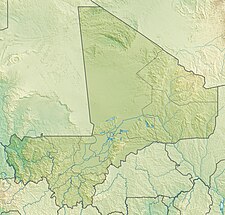| Sidi Yahya Mosque | |
|---|---|
جامع سيدي يحيى Mosquée Sidi Yahya | |
 | |
| Religion | |
| Affiliation | Islam |
| Location | |
| Location | Timbuktu, Tombouctou, Mali |
| Geographic coordinates | 16°46′20″N 3°00′26″W / 16.77224°N 3.00713°W |
| Architecture | |
| Style | Sudano-Sahelian |
| Completed | 1440 |
| Specifications | |
| Minaret(s) | 1 |
| Materials | Banco, Ronnier wood |


The Sidi Yahya Mosque (Arabic: جامع سيدي يحيى; French: Mosquée Sidi Yahya), also known as the Mosque of Muhammad-n-Allah,[2][3] is a mosque and madrasa of Timbuktu in Mali. The construction of the mosque began in 1400 under the leadership of Sheikh el-Mokhtar Hamalla of Timbuktu and was finished in 1440.[4][5]
The mosque was named after its first imam, Sidi Yahya al-Tadelsi.[2] It is part of the University of Timbuktu, which includes the madrasas of Sidi Yahya, Djinguereber and Sankore. The mosque is a typical example of earthen Sudano-Sahelian architecture but also exhibits distinctive forms of plan and ornament. Parts of the Mosque of Sidi Yahya were destroyed by Ansar Dine jihadists on 2 July 2012, following the Battle of Gao.[6] These elements were later reconstructed under the direction of UNESCO team.[6]
- ^ Dubois, Félix (1896). Timbuctoo the mysterious, by Felix Dubois; translated from the French by Diana White. London: New York, Longmans, Green and Co. p. 311.
- ^ a b Gomez, Michael A. (2019-08-27), "Early Gao", African Dominion, Princeton University Press, pp. 19–29, doi:10.23943/princeton/9780691196824.003.0003, ISBN 978-0-691-19682-4, S2CID 242519352
- ^ "Sidi Yahia Mosque, Timbuktu, Mali · Highlights from the Digital Content Library". dcl.dash.umn.edu. Retrieved 2020-11-10.
- ^ "Timbuktu". UNESCO World Heritage Centre. Retrieved 2020-12-08.
- ^ Kane, Ousmane (2016-12-31), Beyond Timbuktu: An Intellectual History of Muslim West Africa, Harvard University Press, p. 264, doi:10.4159/9780674969377-011, ISBN 978-0-674-96935-3, retrieved 2020-12-08
- ^ a b "UNESCO World Heritage Centre - State of Conservation (SOC)". UNESCO World Heritage Centre. Retrieved 2020-12-08.
